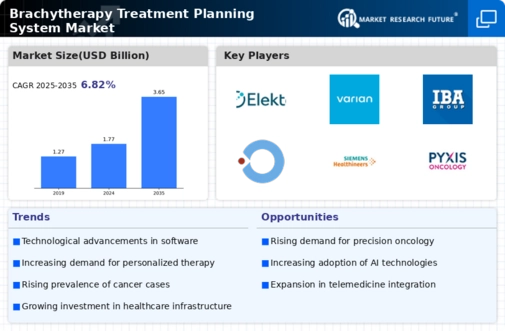Market Growth Projections
The Global Brachytherapy Treatment Planning System Market Industry is projected to experience substantial growth over the coming years. The market is expected to reach 1.77 USD Billion in 2024 and is anticipated to grow to 3.65 USD Billion by 2035. This growth trajectory indicates a compound annual growth rate (CAGR) of 6.81% from 2025 to 2035. Such figures reflect the increasing adoption of brachytherapy as a preferred treatment option for various cancers, driven by advancements in technology, rising cancer incidence, and growing awareness among healthcare providers and patients alike.
Technological Advancements
Technological innovations in brachytherapy equipment and treatment planning systems are propelling the Global Brachytherapy Treatment Planning System Market Industry forward. The integration of advanced imaging techniques, such as MRI and CT scans, with treatment planning software enhances precision in tumor targeting. These advancements not only improve treatment efficacy but also reduce the risk of damage to surrounding healthy tissues. As a result, healthcare facilities are increasingly adopting these technologies, which is reflected in the anticipated market growth to 3.65 USD Billion by 2035. This evolution indicates a shift towards more personalized and effective cancer treatment strategies.
Increasing Cancer Incidence
The rising global incidence of cancer is a primary driver for the Global Brachytherapy Treatment Planning System Market Industry. As cancer cases continue to escalate, the demand for effective treatment modalities, including brachytherapy, is likely to increase. According to projections, the market is expected to reach 1.77 USD Billion in 2024, reflecting the urgent need for advanced treatment planning systems. Brachytherapy offers localized treatment options, which are increasingly preferred due to their effectiveness and reduced side effects. This trend suggests that healthcare providers are investing in sophisticated treatment planning systems to enhance patient outcomes.
Growing Geriatric Population
The global increase in the geriatric population is another significant driver for the Global Brachytherapy Treatment Planning System Market Industry. Older adults are more susceptible to various cancers, necessitating effective treatment options. As the population aged 65 and above continues to grow, healthcare systems are likely to prioritize brachytherapy due to its minimally invasive nature and shorter recovery times. This demographic shift is expected to contribute to a compound annual growth rate (CAGR) of 6.81% from 2025 to 2035, highlighting the increasing reliance on brachytherapy as a viable treatment option for older patients.
Regulatory Support and Funding
Regulatory support and funding for cancer treatment initiatives are critical drivers of the Global Brachytherapy Treatment Planning System Market Industry. Governments and health organizations are increasingly recognizing the importance of investing in cancer care technologies, including brachytherapy. This support often translates into funding for research and development, as well as subsidies for healthcare facilities to adopt advanced treatment planning systems. Such initiatives are likely to enhance the accessibility and affordability of brachytherapy, thereby stimulating market growth. As regulatory frameworks evolve to support innovative treatment modalities, the market is poised for significant expansion.
Rising Awareness and Acceptance
There is a growing awareness and acceptance of brachytherapy among both healthcare professionals and patients, which is positively influencing the Global Brachytherapy Treatment Planning System Market Industry. Educational initiatives and clinical evidence supporting the efficacy of brachytherapy are leading to increased adoption rates. Patients are becoming more informed about their treatment options, often favoring localized therapies that minimize side effects. This trend is likely to drive market growth, as healthcare providers invest in advanced treatment planning systems to meet the rising demand for brachytherapy. Enhanced patient outcomes further reinforce this acceptance, creating a favorable environment for market expansion.


















Leave a Comment